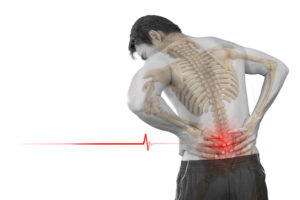Sprains and strains may not sound particularly dramatic in the context of serious injuries in the workplace, but make no mistake, they are a significant cause of disablement, pain, and financial loss.
How do sprains and strains differ?
Sprains
In technical parlance, a sprain occurs when ligaments (the soft fibrous tissue that connects bones) are stretched or torn. Typically, this stretching or tearing occurs due to the overextension of a joint; for example, walking on an uneven surface can lead to an ankle sprain, or landing on an outstretched hand during a fall can cause a wrist strain.
The severity of the sprain will have a large bearing on your ability to function normally and recover. As an illustration, ankle sprains are graded from one to three. A grade one ankle sprain is the mildest form, with no instability of the joint. Grade two occurs when the ligament is partially torn, and the ankle may be slightly loose. Grade three is a complete tear of the ligament, leading to substantial instability of the joint.
Strains
A strain, on the other hand, happens when tendons (the soft fibrous tissue that connects bones to muscles) are stretched or torn. Acute strains tend to occur as a result of trauma or impact to a part of the body, or over-stressing the muscles, perhaps by lifting a heavy item or slipping on an unsafe floor.
In both sprains and strains, the duration of recovery and extent of rehabilitation directly depends on the extent of the injury. Mild cases will often see significant improvement in two to four weeks. More extensive damage can take several months to recover, and you may be unable to work during this time.
You may also require the input of a physiotherapist to recover the normal functioning of the affected part of the body.
If I suspect I have a sprain or strain, should I seek medical advice?
Mild sprains and strains can be treated at home by following the (R)est (I)ce (C)ompression (E)elevate approach. However, severe injuries will require medical intervention and knowing when to seek it is important. In general, it is reasonable to suspect you have a sprain or strain if you have the following symptoms:
- Muscle spasms or cramping
- Tenderness, pain, or weakness around your ankle, foot, wrist, thumb, knee, leg, or back

- It is swollen or bruised
- Limited range of motion
- Inability to bear weight
If you suspect the injury is severe, you are in significant pain, the swelling is getting worse, you have a high temperature, or there are signs of infection, you should seek immediate medical assistance. In severe acute injuries, surgical intervention may be necessary to repair the damage caused. Ultimately, a ligament or tendon that is completely ruptured is not going to repair itself, regardless of the time you give it to heal.
The real consequences of strains and sprains in the workplace
There are many cases in which employees have suffered a serious strain or sprain as a result of an accident while working. In one such case, a man suffered a severe wrist sprain and soft tissue injuries to his shoulder after tripping over work equipment. During the accident, the man put out his hand to break his fall and then landed hard on his left side. According to the facts of the case, the employer was found negligent in:
(i) failing to provide a safe environment for its employees;
(ii) failing to keep the area free from obstruction;
(iii) failing to ensure that the workplace was maintained in an efficient state, in efficient working order and in good repair
(iv) failing to provide or maintain for him a safe means of access to every place at
The injury took four months to recover from and led to a compensation payment of over £5,000.
In a related workplace compensation case, a woman was awarded nearly £50,000 for a severe ankle sprain after slipping at her place of work. The injury was extensive, causing significant damage to the ligaments of the ankle, which required surgery. The large settlement reflected the large impact on the claimant’s personal and future career options, and long-term health.
Claiming a strain or sprain
To claim financial compensation for a strain or sprain, we need to show the injury was of sufficient severity, it has caused you loss, and it was due to the employer’s negligence. In some cases, sprains or strains can occur and the blame cannot be apportioned to a third-party; perhaps by accidentally making an incorrect movement. If you are unsure, contact one of our highly experienced workplace personal injury solicitors, who will be able to determine merits of your case for compensation. If you do win compensation, this will help cover your financial losses (expenses, loss of earnings, additional medical bills etc.), and the pain you have suffered.
At Russell Worth Solicitors we specialise in personal injury claims. If you have suffered a workplace injury and would like a free claim assessment, please call us now on 0800 028 2060 or complete our Online Claim Assessment.

